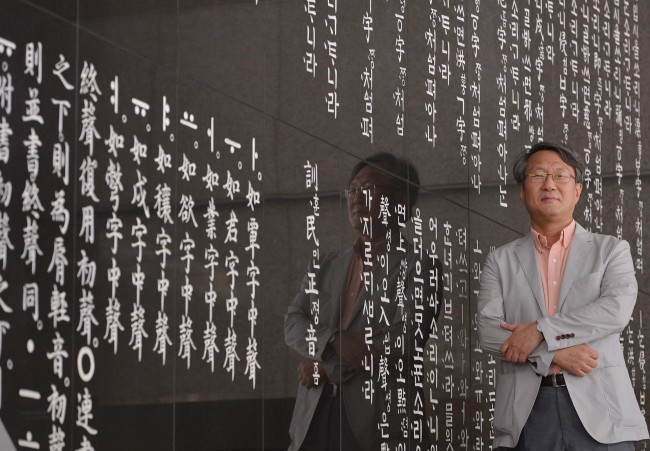Institute aims to export standardized Korean language courses, culture overseas
In 1443, King Sejong invented the Korean alphabet, called Hunminjeongeum, or the “proper phonetic system to educate the people.”
The system was created for those of his subjects who could not read Chinese characters. But he could never have realized that more than 500 years later his invention would be used globally.
The number of Korean languages users worldwide is estimated at more than 80 million. And the figure is growing fast thanks to a rising demand for learning the Korean language sparked by hallyu, the trend known as the Korean Wave.
The rising popularity of Korean pop music known as K-pop, and TV dramas in other Asian countries, the Americas, Europe and even Africa has attracted international interest in Korean culture.
“King Sejong must be really happy about this because his idea of inventing Hunminjeongeum was based on offering people an easy tool to communicate with each other and also to improve their cultural life,” said Song Hyang-keun, president of the International Korean Language Foundation.
“If people from different parts of the world can understand more of Korean culture by learning the Korean language, I think his mission has been accomplished,” he said in an interview with The Korea Herald. The foundation, under the Culture Ministry, operates Korean language centers, called Sejong Institutes, around the world. Most of the classes are free.
 |
Song Hyang-keun, president of the International Korean Language Foundation, stands beside the wall engraved with texts in Huminjeongeum at the National Institute of the Korean Language in Banghwa-dong, Seoul, Monday. (Lee Sang-sub/The Korea Herald) |
The institute was founded in 2009 with 4,301 students enrolled at 17 branches in six countries. The institute, also known as Sejong Hakdang, was established to serve the needs of Koreans living overseas. However, the number of non-Korean students has been growing rapidly in recent years due to hallyu.
Sejong Hakdang’s Los Angeles branch, for example, did not receive many non-Korean students when it opened. At the time, 75 percent of its students were Korean-Americans. But this year, 74 percent of its students are non-Korean. At its basic-level classes, more than 90 percent of the students are non-Koreans.
Currently, there are 76 such institutes, with about half run directly by the government and the rest run by civilian organizations with support from the government. More than 9,000 students are enrolled in Sejong Hakdang this year, the foundation said.
Taking advantage of the K-pop fever as the Korean government plans to increase the number of Sejong Hakdang branches to 90 by the end of this year, and to 200 by 2016.
Not only with the popularity of hallyu but also with a growing number of Korean businesses entering overseas markets that create jobs for the locals, the demand to learn the language will grow even more, said Song who is professor at Busan University for Foreign Studies. Song is one of the leading Korean scholars who have developed Korean-language teaching methods targeted at foreigners.
“I think the Sejong Institute should take a central role in not only providing language programs but also in promoting Korean culture in general overseas,” Song, 55, said. “If we could keep the demand growth, it is possible to globalize the Korean language in the future like other popular foreign languages.”
To achieve that goal, Song argues that the government needs to standardize the format of Korean language programs and textbooks.
“There are more than 4,000 textbooks on Korean language registered around the world. But teachers find it difficult to choose the right books to fill the different educational needs of the students. So we need to give a standardized guideline for teachers so that they can teach the language easily and efficiently,” he said, adding that the Korean language and its grammar were relatively difficult for foreigners to learn.
He also suggested that the programs shouldn’t be too academic.
“A recent study revealed that most students are taking the class for their personal interests so that they can understand more about Korean dramas or send fan letters to Korean stars. This means the level of programs shouldn’t have to be high,” he said.
He said the government should also try to make the Korean language courses part of the regular curriculum in elementary, middle and high schools abroad.
Students say they are satisfied with programs offered at the Sejong Institutes.
“Sejong Institute has helped me take what was originally just a little interest and help develop it with the language programs. I am really satisfied, and the teacher that taught me is very dedicated to his work and I feel that I have learnt so much,” said Marcela Purnonmo, a Web designer in Australia, in an email interview. Purnonmo who has been taking Korean classes since last year after she took interest in Korean dramas and K-pop groups and their music.
But some said more teachers and new educational content would draw more attention from the locals.
“It can be improved if there (were) more students who will enroll, as well as more Korean teachers who can teach at our institute. It would also help if there (was) a buddy system so that we can have someone to practice the language with,” said Maria Bianca Gail Paris, 23, a financial planning analyst at a multinational company in the Philippines.
“I hope that someday I will not have to rely on English subtitles when watching Korean romantic comedies, and also to speak the language fluently with my Korean friends,” she added.
By Cho Chung-un (
christory@heraldcorp.com)








